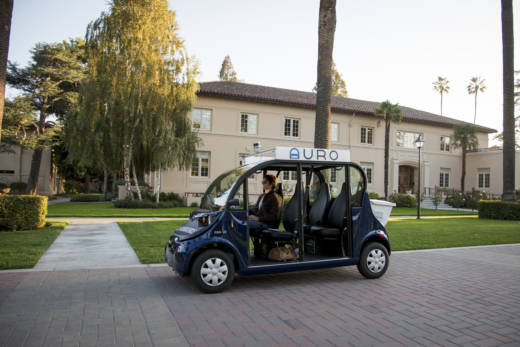Driverless Cars Come to Santa Clara University, Sort Of

These days at Santa Clara University, you can get a glimpse of how the automated future will unroll. Yesterday the school started offering a driverless shuttle service.
I took a ride on the shuttle, which is believed to be the first self-driving service on a college campus. It basically looks like a pimped-out golf cart.
“That’s exactly what it is. It’s an off-the-shelf golf cart that we’ve retrofitted with our drive-by-wire computerized units and sensors,” said Ben Stinnett, a hardware engineer at Auro, the Sunnyvale startup that built this self-driving shuttle.
The shuttle service is part of a two-month pilot program. During that time, an Auro engineer sits in the front seat ready to take over if systems fail. The shuttle took me on a 1-mile loop at its maximum speed of 7 mph. And rather than maneuver around pedestrians, it slows down to follow them at their speed to ensure safety. All this makes for a very slow ride.
While Google and Tesla are grabbing headlines for plans to bring self-driving cars to the open road, it could be another decade before consumers can buy them. In the meantime, there’s a cottage industry of startups deploying similar technology, but in more controlled settings.
Srinivas Reddy, a co-founder of Auro, says mapping cities and counties is an expensive endeavor, but mapping a college campus is within a startup's budget.
“And hence, we deploy these much faster than the other companies that are eyeing for the passenger car market,” he said.
That means Auro can get to market faster. In nearby Redwood City, Starship Technologies recently won approval to run a pilot program where robots deliver groceries and food from restaurants to homes and businesses in a 5-mile radius. Robert Siegel, who teaches at Stanford’s Graduate School of Business, says the move to automation will be incremental.
“We are gonna continue to see more and more examples of autonomous systems touch every part of our lives,” Siegel said.
He says sticking to controlled settings with low stakes also allows consumers to become more comfortable with autonomous systems.